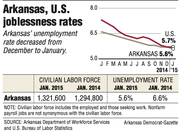Arkansas' unemployment rate in January dipped to 5.6 percent from 5.7 percent in December, the U.S. Bureau of Labor Statistics said Tuesday.
But the bureau's recent revisions in the state's labor force data over past months indicate that Arkansas is undergoing a stronger recovery from the recession than had first been thought.
"The trends are now showing increasing employment and a declining unemployment rate that persisted right through all of 2014," said Michael Pakko, chief economist at the Institute for Economic Advancement at the University of Arkansas at Little Rock. "And it looks like those trends are continuing through the first part of this year."
The national unemployment rate was 5.7 percent in January and declined further to 5.5 percent in February.
It has taken more than seven years, but Arkansas' number of employed workers has almost matched those who were employed in the state when the recession began in December 2007, Pakko said.
There were 1,247,200 Arkansans employed in January, an increase of 26,800 from January 2014. The number of unemployed Arkansans in January was 74,400, down 11,200 from a year earlier.
There were 9,100 more employed Arkansans in January than in December, a record one-month increase, Pakko said.
November and December had first been reported as record one-month increases, but now those increases are much smaller with the data revised, Pakko said.
The January increases looked "so spectacularly big," said Kathy Deck, director of the Center for Business and Economic Research at the University of Arkansas in Fayetteville, that she anticipates they will be revised downward a year from now.
"The great news is that the labor force is growing and growing substantially," Deck said. "That's what you expect with an expansion."
For many months over the past two years, the monthly release of labor force statistics showed that the unemployment rate was gradually declining but so was the size of the labor force. Apparently people were leaving the labor force, either by moving to other states or simply giving up looking for work, economists speculated.
The state's labor force is the sum of the number of employed and unemployed Arkansans.
Both Pakko and Deck have been puzzled for months by the seemingly contradictory reports.
But annual revisions of employment data made last week by the Bureau of Labor Statistics now show that "everything is a little bit more consistent now," Pakko said.
There were substantial changes made to the employment statistics, Pakko said.
"We had seen over the past couple of years some very sharp swings in employment and the labor force," Pakko said. "There was a big decline in 2013 and another huge resurgence in 2014."
The big swings were "revised away" by the recent updating, Pakko said.
"Those big swings were apparently anomalies," Pakko said.
Arkansas' employment has been increasing since the beginning of last year, Pakko said. Some of the increases weren't as large as previous data had suggested, he said.
"But there still has been a clear upward trend," Pakko said.
Nine of Arkansas' 11 industry sectors saw job increases in January compared with January last year. The trade, transportation and utilities sector had 7,700 more jobs in January than a year earlier, followed by leisure and hospitality, up 6,700 jobs in the past year, and professional and business services, up 5,400 jobs.
Professional and business services is a relatively high-paying sector.
"It looks like [professional and business services] is growing stronger than we first thought," Pakko said.
Overall, the number of nonfarm jobs in the state was up 29,500 in January compared with a year earlier.
North Dakota had the lowest unemployment rate in the country in January at 2.8 percent, followed by Nebraska at 2.9 percent, South Dakota and Utah at 3.4 percent each, and Minnesota at 3.7 percent.
Mississippi and Nevada had the highest unemployment rates at 7.1 percent each, followed by Louisiana at 7.0 percent, California at 6.9 percent and Tennessee at 6.7 percent.
Business on 03/18/2015
